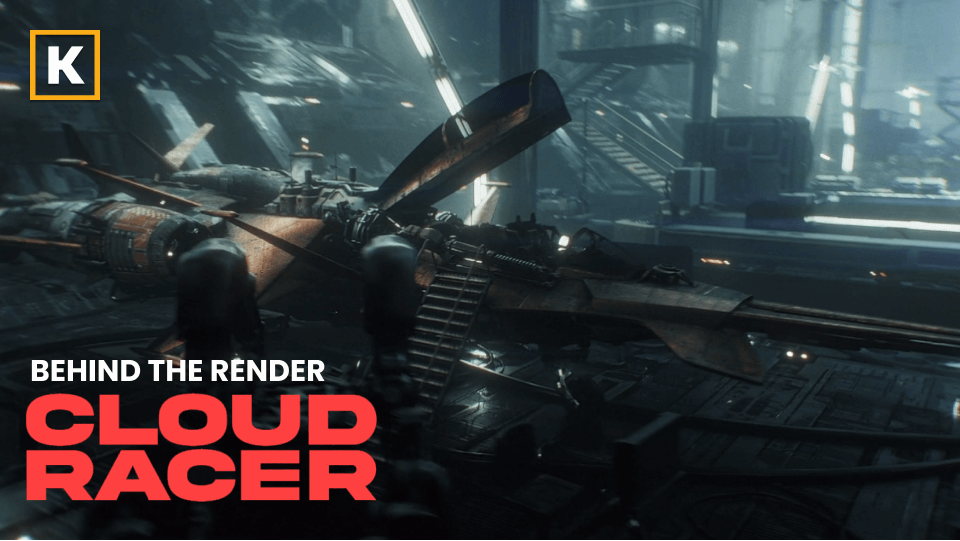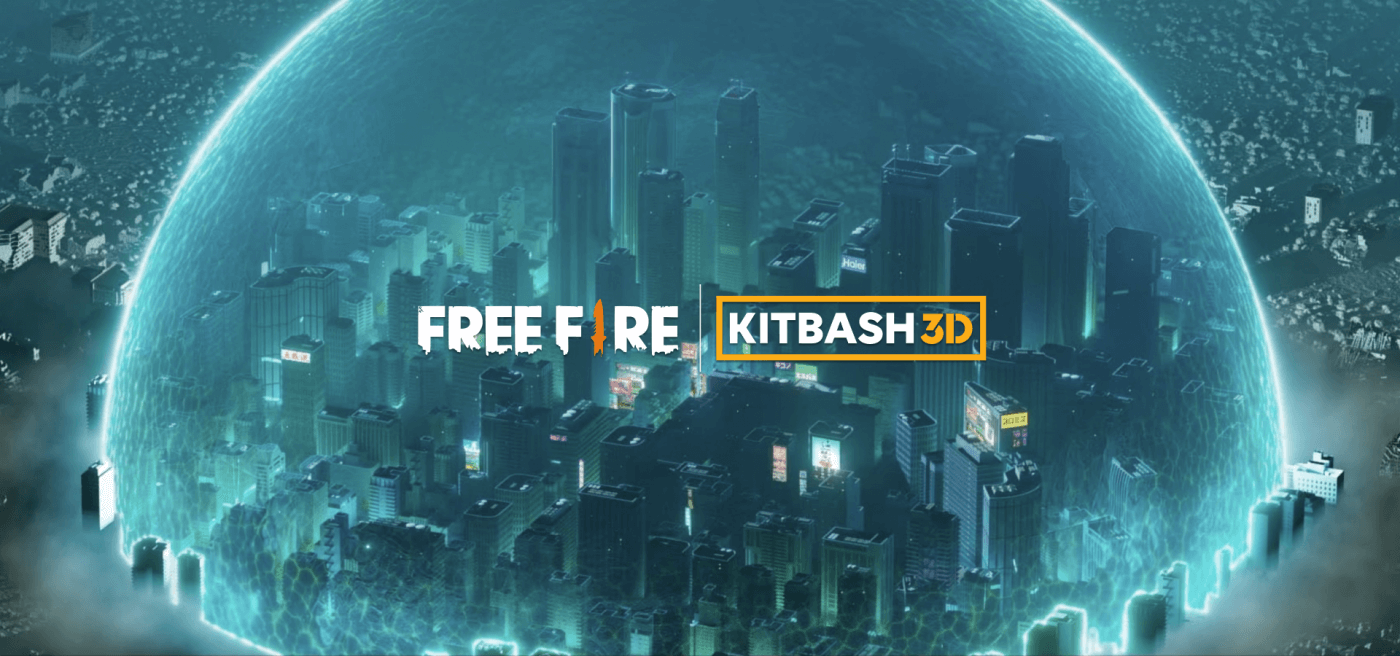Following the release of VFX studio Impossible Object's sci-fi short film, "The Cloud Racer," the film's director, Joe Sill, sat down to chat with us. We covered some of the processes behind the development of the film, using KitBash3D Kits to streamline production, and his motivation to explore production tools to tell meaningful stories. Before we dive in, if you haven't seen it yet, watch "The Cloud Racer", then check out the breakdown video to go behind the scenes of the creation of the film.
Thanks so much for talking with us today, Joe. With the new breakdown video of The Cloud Racer, it’s so cool to see a bit behind the magical curtain of Impossible Objects, can you give us a broad stroke idea of your team’s scope of work?
Thanks to you all! Impossible Objects is still in the early stages of its life, but so far in our two years of existence we’ve had the opportunity to highlight virtual production and develop real-time projects with brands like Google, Blizzard, Honda, Toyota, and even blockbuster Hollywood productions that are interested in the next evolution of filmmaking.
How long did the project take, from initial concept to final delivery?
[Laughs] Much longer than I’d like to remember! In total, the short-film version of “The Cloud Racer” took a little over a year in total to finish in between the other jobs we do at Impossible Objects. We’d written the screenplay in late 2020, and throughout the course of the next two years we built a skeleton team to produce the film entirely within Unreal Engine, all while developing the feature film's screenplay in tandem.
Can you discuss more about your creative workflow for the project? What was your process for building your future Los Angeles “Ghost City” once you had it conceptualized?
Once we had the script for the short and landed on a climate-ravaged Los Angeles as the setpiece, we started fleshing out looks for the environment and the racecraft on an early set of mood boards which quickly became the bible for how we’d approach the lookdev of the worlds and the ships.
Ghost City Los Angeles was manifested in large part thanks to KB3D’s Warzone and Aftermath Kits, which allowed us to jump in and start developing the environment entirely in Unreal Engine from the start, and actually use that level as the final environment to keep iterating on throughout previsualization and then on into final.
Luc Delamare, our Head of Tech and VP Supervisor, even took a rough 3D geometry of Los Angeles from Google Earth to then lay in KB3D assets into exact placements and get a rough match of the Downtown Los Angeles cityscape. We also used other assets Quixel provided to give some life to the deadened world with various foliage, decals, and high-fidelity materials.
That is so cool! We know you used Unreal Engine to create everything from virtual environments to lighting, camera, ingesting mocap performances, and final cinematics in-engine, really showcasing how much lift UE5 offers for virtual production. How did you find that KB3D assets performed in UE5?
KB3D had just optimized their Kits to ingest directly into UE around the time we started doing lookdev, and it was so much more efficient than I expected. No need to relink materials or geometries – it was immediately compatible and just allowed us to get straight to layout and building out the worlds.
What was the biggest benefit or advantage that using KB3D provided your team on the project?
I’ve used KB3D a number of times on smaller endeavors throughout the years, but this was the first time I used KB3D as the backbone for every environment in a narrative project, especially while working holistically in Unreal Engine. The 3D assets are beautifully designed, intricately detailed, and extremely accessible, with a healthy breadth of options in style and genre. For a small independent team standing up large scale environments that demand a lot of detail within days it's not only convenient — it’s essential.
What was the biggest challenge you faced during the project?
The biggest challenge was the scope of the project for what was essentially an experimental passion project. It was considerably more ambitious than it had any right to be, and had it not been for the efficiencies of Unreal Engine, MetaHuman Creator and KB3D, I’m not sure it would’ve gotten done. We were hugely reliant on KB3D allowing us as a skeleton team to build out these massive worlds and still have flexibility to be creative and make adjustments.
That is so great to hear – we love enabling and inspiring creators like you! Impossible Objects is a “world-building lab" that focuses on virtual production and tests tools like KB3D for helping those production pipelines. Did the KB3D assets themselves help inspire or create new solutions to existing challenges?
KB3D is, at this point, a critical and essential tool to jumpstarting the previsualization and virtual art department teams at Impossible Objects. Employing KB3D assets in previs and VAD allows us to start visualizing immediately, during a time in which we’re typically used to only seeing storyboards and mood boards.
There’s also an exponentially growing demand for CG environments that can perform in real-time on LED volume stages, and it’s relieving that KB3D is committed to meeting that demand, empowering artists with high fidelity assets that are also optimized to actually perform under pressure. We’re fascinated by the volume stage virtual production process and want to utilize KB3D here too as much as we can.
We can’t wait to see more of what you’re working on and we’re looking forward to helping in the ways that we can! With the continuing content boom and increasing demand for projects, do you see the industry’s overall attitude toward using pre-made assets evolving?
Absolutely. The assets from KB3D are built by extraordinarily talented artists and shared with the community to allow other artists to represent their ideas quickly while expanding upon and developing new ways of using these assets, discovering ideas they probably wouldn’t have found if they were forced to create all of their assets from scratch.
It’s no different than a live action production designer sourcing key assets, props, or even locations that would fit a screenplay’s described prop or location. Art directors will find what helps them get closest to the idea and then mold and shape (and KitBash!) from there to make it their own – it should be no different in visual effects.
At Impossible Objects, you and your team are consistently at the forefront of technology in filmmaking, what industry trends are you following right now?
We’re eager to see more and more lineage pipelines find ways to communicate with real-time performance. Simulations and animation are still standardized in traditional pipelines that are pretty restrictive, and there’s a space here that I think is ripe for real-time solutions.
We’re also fascinated by the space in entertainment where real-time tools can give independent teams the ability to keep original IP alive, and breathe new life to a new class of independent films that have scope. We aren’t seeing enough large-scale original ideas in film. But, if you build it, they will come.
How did you get your start in the industry?
I got my start in the film industry by creating a speculative film for Tesla back in 2013 that Elon Musk saw and shared on Tesla’s homepage, which was a shock to me and all my peers that had worked on it. It was a dream to jumpstart my directing career with that piece, which lead to working on projects with top brands such as Apple, NASA, Google, Amazon, Disney, Nike, and Blizzard. I even got to direct my own feature film before starting Impossible Objects.
I’ve always believed in the power of manifesting your creative potential by self-generating and producing content you believe in. Just develop your own ideas in whatever way you can. That’s the only way to actually see their maximum potential. Tools like KB3D actually make that desire possible, and I’m so grateful there’s a team out there like that devoted to empowering the artist.
What do you enjoy the most about the work that you do?
I love building worlds, telling complex human stories, and finding new ways to do things. I also love working with curious-minded people. The sparks of joy found when you discover new and exciting ways to do things together is what gets me up in the morning. As long as my career continues to chase curiosity, I’ll be happy.
Thanks again, Joe and to the entire Team at Impossible Objects for giving us a closer look into the virtual production process behind "The Cloud Racer."










